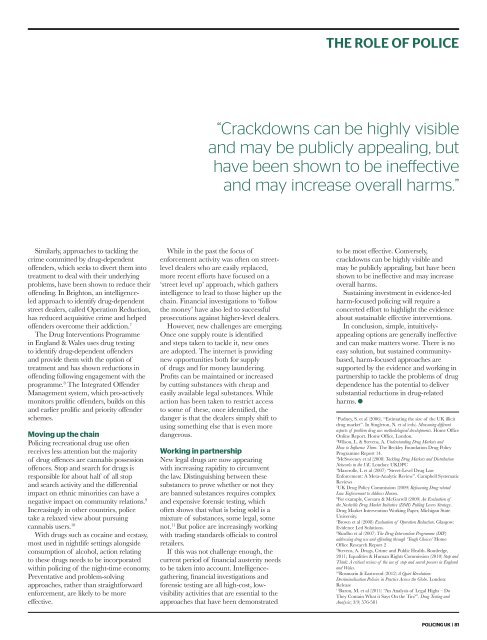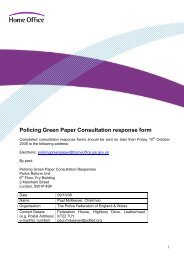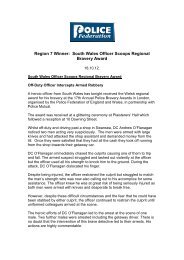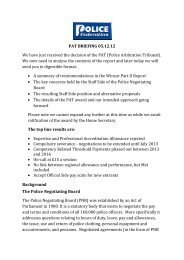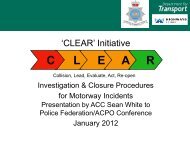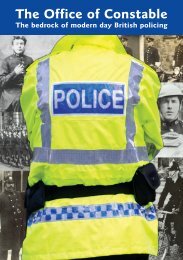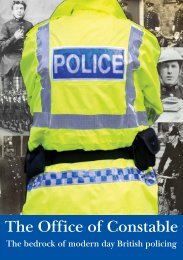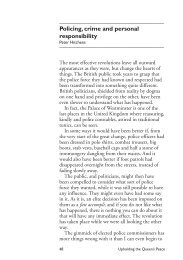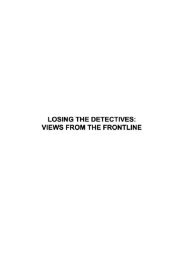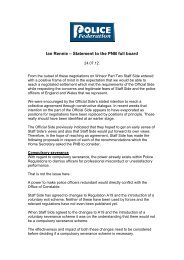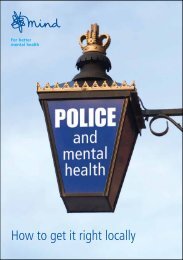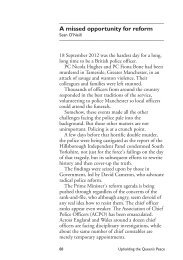Policing UK 2013 - Police Federation
Policing UK 2013 - Police Federation
Policing UK 2013 - Police Federation
Create successful ePaper yourself
Turn your PDF publications into a flip-book with our unique Google optimized e-Paper software.
THE ROLE OF POLICE<br />
“Crackdowns can be highly visible<br />
and may be publicly appealing, but<br />
have been shown to be ineffective<br />
and may increase overall harms.”<br />
Similarly, approaches to tackling the<br />
crime committed by drug-dependent<br />
offenders, which seeks to divert them into<br />
treatment to deal with their underlying<br />
problems, have been shown to reduce their<br />
offending. In Brighton, an intelligenceled<br />
approach to identify drug-dependent<br />
street dealers, called Operation Reduction,<br />
has reduced acquisitive crime and helped<br />
offenders overcome their addiction. 7<br />
The Drug Interventions Programme<br />
in England & Wales uses drug testing<br />
to identify drug-dependent offenders<br />
and provide them with the option of<br />
treatment and has shown reductions in<br />
offending following engagement with the<br />
programme. 8 The Integrated Offender<br />
Management system, which pro-actively<br />
monitors prolific offenders, builds on this<br />
and earlier prolific and priority offender<br />
schemes.<br />
Moving up the chain<br />
<strong>Policing</strong> recreational drug use often<br />
receives less attention but the majority<br />
of drug offences are cannabis possession<br />
offences. Stop and search for drugs is<br />
responsible for about half of all stop<br />
and search activity and the differential<br />
impact on ethnic minorities can have a<br />
negative impact on community relations. 9<br />
Increasingly in other countries, police<br />
take a relaxed view about pursuing<br />
cannabis users. 10<br />
With drugs such as cocaine and ecstasy,<br />
most used in nightlife settings alongside<br />
consumption of alcohol, action relating<br />
to these drugs needs to be incorporated<br />
within policing of the night-time economy.<br />
Preventative and problem-solving<br />
approaches, rather than straightforward<br />
enforcement, are likely to be more<br />
effective.<br />
While in the past the focus of<br />
enforcement activity was often on streetlevel<br />
dealers who are easily replaced,<br />
more recent efforts have focused on a<br />
‘street level up’ approach, which gathers<br />
intelligence to lead to those higher up the<br />
chain. Financial investigations to ‘follow<br />
the money’ have also led to successful<br />
prosecutions against higher-level dealers.<br />
However, new challenges are emerging.<br />
Once one supply route is identified<br />
and steps taken to tackle it, new ones<br />
are adopted. The internet is providing<br />
new opportunities both for supply<br />
of drugs and for money laundering.<br />
Profits can be maintained or increased<br />
by cutting substances with cheap and<br />
easily available legal substances. While<br />
action has been taken to restrict access<br />
to some of these, once identified, the<br />
danger is that the dealers simply shift to<br />
using something else that is even more<br />
dangerous.<br />
Working in partnership<br />
New legal drugs are now appearing<br />
with increasing rapidity to circumvent<br />
the law. Distinguishing between these<br />
substances to prove whether or not they<br />
are banned substances requires complex<br />
and expensive forensic testing, which<br />
often shows that what is being sold is a<br />
mixture of substances, some legal, some<br />
not. 11 But police are increasingly working<br />
with trading standards officials to control<br />
retailers.<br />
If this was not challenge enough, the<br />
current period of financial austerity needs<br />
to be taken into account. Intelligencegathering,<br />
financial investigations and<br />
forensic testing are all high-cost, lowvisibility<br />
activities that are essential to the<br />
approaches that have been demonstrated<br />
to be most effective. Conversely,<br />
crackdowns can be highly visible and<br />
may be publicly appealing, but have been<br />
shown to be ineffective and may increase<br />
overall harms.<br />
Sustaining investment in evidence-led<br />
harm-focused policing will require a<br />
concerted effort to highlight the evidence<br />
about sustainable effective interventions.<br />
In conclusion, simple, intuitivelyappealing<br />
options are generally ineffective<br />
and can make matters worse. There is no<br />
easy solution, but sustained communitybased,<br />
harm-focused approaches are<br />
supported by the evidence and working in<br />
partnership to tackle the problems of drug<br />
dependence has the potential to deliver<br />
substantial reductions in drug-related<br />
harms.<br />
1<br />
Pudney, S. et al (2006). “Estimating the size of the <strong>UK</strong> illicit<br />
drug market”. In Singleton, N. et al (eds). Measuring different<br />
aspects of problem drug use: methodological developments. Home Office<br />
Online eport. Home Office, London.<br />
2<br />
Wilson, L. Stevens, A. Understanding Drug Markets and<br />
How to Influence Them. The Beckley Foundation Drug Policy<br />
Programme Report 14.<br />
3<br />
McSweeney et al (2008) Tackling Drug Markets and Distribution<br />
Networks in the <strong>UK</strong>. London <strong>UK</strong>DPC<br />
4<br />
Maerolle, L et al (200) Street-Level Drug Law<br />
Enforcement A Meta-Analytic eview. Campbell Systematic<br />
Reviews<br />
5<br />
<strong>UK</strong> Drug Policy Commission (2009) Refocusing Drug-related<br />
Law Enforcement to Address Harms.<br />
6<br />
For example, Corsaro & McGarrell (2009) An Evaluation of<br />
the Nashville Drug Market Initiative (DMI) Pulling Levers Strategy.<br />
Drug Market Intervention Working Paper, Michigan State<br />
University.<br />
7<br />
Brown et al (2008) Evaluation of Operation Reduction. Glasgow<br />
Evidence Led Solutions.<br />
8<br />
Skodbo et al (2007) The Drug Intervention Programme (DIP)<br />
addressing drug use and offending through ‘Tough Choices’ Home<br />
Office esearch eport 2<br />
9<br />
Stevens, A. Drugs, Crime and Public Health. outledge,<br />
2011; Equalities & Human Rights Commission (2010) Stop and<br />
Think: A critical review of the use of stop and search powers in England<br />
and Wales.<br />
10<br />
Rosmarin & Eastwood (2012) A Quiet Revolution:<br />
Decriminalisation Policies in Practice Across the Globe. London<br />
Release<br />
11<br />
Baron, M. et al (2011) An Analysis of Legal Highs – Do<br />
They Contain What it Says On the Tin?”. Drug Testing and<br />
Analysis; 3(9) 576-581<br />
POLICING <strong>UK</strong> | 81


